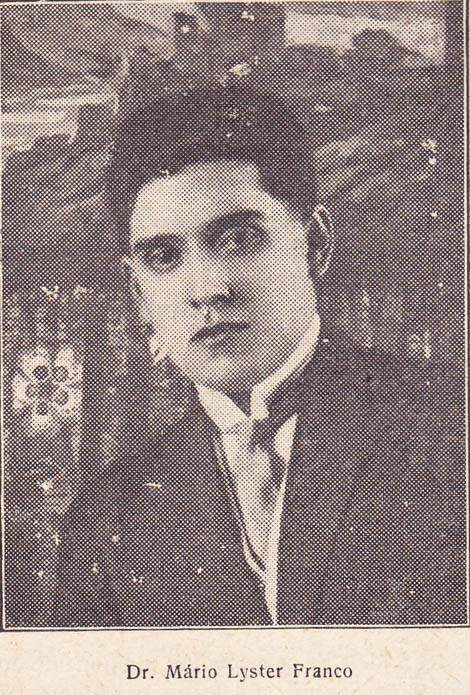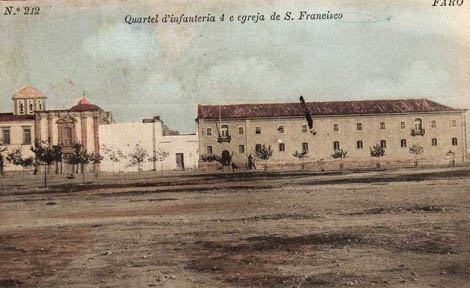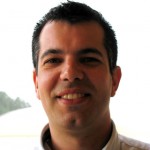 After crossing the Serra do Caldeirão by car, the Head of State took the presidential convoy at Gare de Almancil-Nexe (from which he had left in Ermidas-Sado), to arrive shortly thereafter in Faro.
After crossing the Serra do Caldeirão by car, the Head of State took the presidential convoy at Gare de Almancil-Nexe (from which he had left in Ermidas-Sado), to arrive shortly thereafter in Faro.
It was a few minutes after three o'clock in the afternoon, on that Monday, February 15, 1932, when the then President of the Republic sighted the Algarve capital.
According to “Diário de Notícias” the reception was impressive: “When the train enters the station of Faro hundreds of rockets went up into the air, and loud cheers were heard in indescribable enthusiasm. The station was packed with people."
At the station were all civil and military authorities, a large number of local entities, students, as well as many people, with the closure of all commercial and industrial establishments in the city having contributed to this, determined by the Commercial and Industrial Association.
The honor guard was made by a military force and a picket of firemen, while two philharmonics performed the “Portuguese”. The head of state received the greetings of the president of the Chamber of Faro, Mário Lyster Franco, and of all the councilors, for later, and at “a great deal of cost due to the immense crowd that filled the square in front of the station”, ascend together with his entourage to several cars parked there. The president took his place "in an elegant 'landeau', riding an officer to the helm."
The procession crossed the city towards the Town Hall, where the official reception would take place, being in the course of and in the words of the newspaper “O Século”, “the head of state much hailed by the people, who flocked to the sidewalks and leaned on the windows of buildings, from which hangings hung and flowers were thrown, which completely littered the pavement of the streets. At various points there were other bands of music, and mortars were constantly exploding. When the procession reached the Chamber, the demonstrations reached delirium. In the air, the seaplanes, which had followed from Lisbon, were evolving at a little height, and the bells tolled festively, and a spinning wheel of rockets was burned”.
After the visit to the honor guard, made up of a Navy force and a firefighters picket, which took place amidst cheers of the people, the president entered the Paços do Concelho.
 In the session room, he was awaited by "civil and military authorities, the bishop, officials from the gunboats in the port and many people." The president, accompanied by ministers, presided over the ceremony. “Mr. Dr. Mário Lyster Franco, on behalf of the Municipalities of Faro and from other councils in the Algarve, he greeted Sr. General Carmona, thanking him for his visit, which he considers a fact worthy of being marked in golden letters in the history of the Algarve, where so few heads of state have come. He warmly praised the work of regeneration of the men of the 28th of May, who have done a lot for the aggrandizement of Portugal and still will do much”.
In the session room, he was awaited by "civil and military authorities, the bishop, officials from the gunboats in the port and many people." The president, accompanied by ministers, presided over the ceremony. “Mr. Dr. Mário Lyster Franco, on behalf of the Municipalities of Faro and from other councils in the Algarve, he greeted Sr. General Carmona, thanking him for his visit, which he considers a fact worthy of being marked in golden letters in the history of the Algarve, where so few heads of state have come. He warmly praised the work of regeneration of the men of the 28th of May, who have done a lot for the aggrandizement of Portugal and still will do much”.
The cabinetmaker Francisco Assis, the corkmaker Manuel Francisco Lourenço and the seafarers Francisco José Dentinho and Pedro Castelão were then presented to the President of the Republic, who were awarded the Order of Industrial and Agricultural Merit. This type of decoration, which was intended to honor “those who set such a good example of a life of honest work”, in the words of the president, would be a constant throughout the presidential visit, as will be seen.
The presentation of the honorees was crowned with “a thunderous round of applause”, after which the head of State's speech began.
“O Século” wrote about this one: “On behalf of the Government, I thanked the reception that had just been given to it and asked the people of Faro that your thanks were transmitted. The Government's work – he declared – only those whose eyes are darkened by envy or intrigue will not see it! The Government has had good collaborators – he added – among which are the administrative corporations. Terreiro do Paço was somewhat ignorant of what the Algarve was. Its roads were impassable and its ports silted up. The Dictatorship would seek to remedy these ills, within the financial possibilities of the Treasury. Let there be faith, and everything will happen, for the good of the Country”. The DN added: “Recalling the May 28 Movement, he stated that it was made for the prestige of the country, only the bad Portuguese do not want to see the work of the Dictatorship. It has done little by itself, but its ministers have done a great work of national aggrandizement. He then appealed to the loyalty of all the Portuguese, saying that with good will everyone fits into our land. And it ended with a cheer for the Fatherland and the Republic, responded to with enthusiasm”.
After the presentations made by the official entities in the President's office, the head of State left the Chamber towards the Maritime Department, with the people returning to “demonstrate with warmth and joy”.
The Maritime Department (located in the Episcopal Palace building) was partly transformed into a presidential palace, where the head of State was received there, “by Commander Ramalho Ortigão, and all the officers, with the same warm demonstrations being repeated at the entrance. of sympathy. This was followed by the visit and inauguration of the Maritime Museum, formerly the Maritime Industrial Museum of the Pedro Nunes School, where João Vaz's valuable seascapes can be found, representing wonderful aspects of the coast, fishing phases, etc. There are also fish collections, samples of wood and rigging, miniature boats and sardine and tuna fishing frames. This being the best Portuguese maritime museum” (1).
 After the inauguration, Commander Ortigão requested the interference of the Head of State with the Government, so that it would grant a sponsorship for the expansion of the recently inaugurated museum, as well as his intervention in favor of a sailor unjustly sentenced to prison, of his name Francisco Pereira.
After the inauguration, Commander Ortigão requested the interference of the Head of State with the Government, so that it would grant a sponsorship for the expansion of the recently inaugurated museum, as well as his intervention in favor of a sailor unjustly sentenced to prison, of his name Francisco Pereira.
The president promised "to take an interest in these matters, expressing his enthusiasm for the museum."
The presidential delegation then went to the Liceu João de Deus, where they were received “by the dean, Dr. José Júlio Rodrigues, by the entire faculty, by the students with the banner of the respective association, etc. The dean thanked the visit, believing that it will be the magic wand capable of modifying the organization of that educational establishment, which is extremely difficult due to the lack of hygienic and installation conditions and the lack of teaching material, finally requesting the construction of a new high school”.
In the same way that he had promised to be interested in expanding the museum, the president promised to talk about the matter with the minister of education. This was followed by a visit to the school's canteen, which culminated in a “Port of honor”, where the general once again thanked the reception he had received.
Afterwards, the Barracks of Hunters 4 were visited, “whose squares were formed in the parade, and the Head of State reviewed them”. Inside the barracks, in the sergeants' room, a portrait of General Carmona was unveiled by the minister of war, declaring “the sergeant-assistant the admiration, respect and loyalty of his comrades, his discipline and willingness to serve the Fatherland”. Statements that touched the president and led him to "incite the sergeants to be faithful fulfillers of their duties, not being taken in by those who promise promotions in cases of rebellion, who do not honor anyone."
At the end of the visit, after the presentation of the officers by the commander, the ministers dispersed to the houses that had been assigned to them, to rest for a few moments, and the president retired to the Maritime Department building, where he stayed.
At night, in the words of “O Século”, the city presented a “fairy aspect with its showy illuminations in the streets, gardens and facades of buildings. The Manuel Bívar garden had numerous rows of colored electric lamps. Four bands played there, in bandstands. All the while the mortars thundered. A huge crowd roams the streets and squares, stopping above all in front of the profusely lit buildings of the Civil Council and Government”.
Meanwhile, visitors took part in a gala banquet, in the main room of the Paços do Concelho, “visibly lit”, together with two hundred guests.
(Continued)
1-Remember that the museum was created on January 4, 1889, but after occupying several locations in Faro, without special conservation care, was transferred to the Navy in 1916, through the School of Marine Students of the South. 1923, that the collections were put away in an old barracks. Its degradation was greatly accentuated, and in 1929 the collections had a deplorable appearance. Since then, they have been restored and the museum reorganized, culminating its inauguration with the visit of President Carmona. Read the 1st part of this article here:Read the 2st part of this article here:Read the 3st part of this article here:
Author Aurélio Nuno Cabrita is an environmental engineer and researcher of local and regional history


















Comments